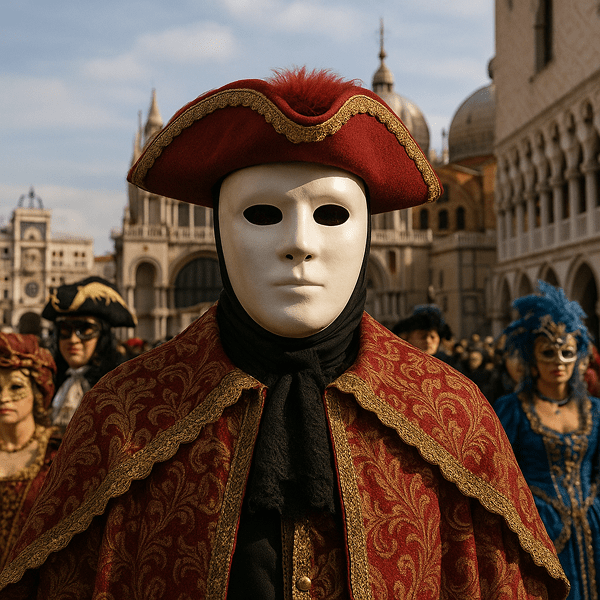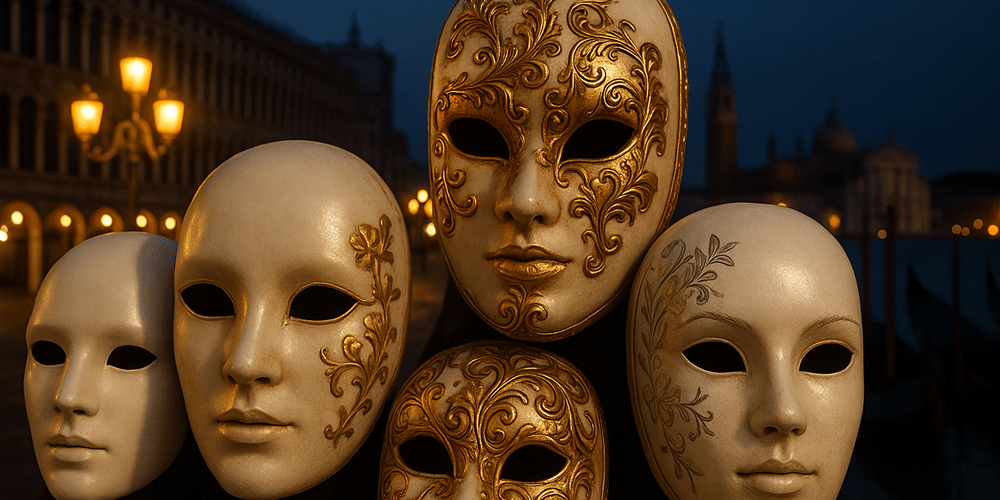The Volto mask is one of the most recognizable and enduring symbols of Venetian culture, deeply intertwined with the city’s history of masquerade and celebration. Traditionally worn during the illustrious Carnival of Venice, the Volto — meaning “face” in Italian — is famed for its smooth, blank features and subtle elegance. The mask typically covers the entire face, with softly contoured cheeks, a rounded chin, and gentle lines around the eyes and lips. Its simplicity is its trademark, often painted white or adorned with minimal decoration, which sets it apart from the more elaborate Venetian masks such as the Bauta or Moretta. The Volto is an emblem of anonymity and equality, reflecting the spirit of Venice during its golden age. Its origins date back to the 18th century, though its roots and stylistic influences can be traced even further into Venetian history. Another iconic Venetian mask you may encounter is the Colombina Mask, which is famous for its half-face design and ornate decoration.
Historical Origins
The Volto mask emerged as a significant element of Venetian masquerade culture in the 18th century, though the practice of mask-wearing in Venice predates this period by several centuries. The name “Volto,” directly translated as “face,” emphasizes the mask’s role in both concealing and revealing identity. Venice, as a mercantile and cosmopolitan republic, developed a complex social environment where anonymity was valued, particularly during Carnival and other public festivities. The mask’s understated design evolved in response to the societal need for discretion and freedom. Over the years, the Volto mask has been depicted in numerous historical documents, paintings, and literary works, often associated with the intrigue and elegance of Venetian society. Early examples of the Volto can be seen in museum collections, where they are sometimes displayed alongside other iconic Venetian masks.
Cultural Significance and Symbolism
The Volto mask holds deep cultural significance in Venetian society, symbolizing themes of anonymity, egalitarianism, and liberation from societal constraints. By donning a Volto mask, wearers could transcend class boundaries, interact freely, and participate in events without fear of judgment or repercussion. This was especially important in a city defined by strict social hierarchies and political intrigue. In a broader sense, the mask embodies the duality of Venetian life — public spectacle and private secrecy. While the Volto itself does not have direct religious connotations, its use during Carnival, a festival rooted in pre-Lenten celebrations, connects it to the rhythms of the Christian calendar. Over time, the mask has also become a symbol of Venetian resilience and artistry, celebrated in local legends and immortalized in countless stories and artworks.
Materials and Craftsmanship
Traditionally, Volto masks are crafted from papier-mâché, a material prized for its lightness and malleability. The process begins with sculpting a clay or plaster model, over which layers of paper and glue are applied. Once dry, the mask is carefully removed, refined, and painted. Artisans may use tempera or acrylic paints, gilding, and subtle embellishments such as gold leaf or fine lace. The tools involved include brushes, carving knives, and specialized forms for molding. Although the classic Volto is white, contemporary versions may feature delicate patterns, metallic accents, or even jewel-like decorations. While the essential shape remains consistent, slight variations can be found in different Venetian workshops, each reflecting a unique artisanal style. The color white, most common for the Volto, is traditionally associated with purity and the blank canvas of identity, while selective use of gold or silver adds a sense of opulence.
Functions and Uses
The Volto mask is most famously associated with the Carnival of Venice, where it is worn by revelers seeking both anonymity and participation in the festive chaos. In earlier centuries, the mask was also used during other public events and ceremonies, including theatrical performances, political gatherings, and even some religious observances. Its simple design made it suitable for both men and women, enabling widespread use across all strata of Venetian society. Over the centuries, as political and social climates changed, the use of the Volto mask became more focused on cultural celebration and artistic expression. Today, the mask remains an essential part of Carnival, but it is also popular as a decorative object, a souvenir, and a symbol of Venetian heritage. The adaptability of the Volto mask has ensured its continued relevance, even as the context of its use has evolved.

Regional Variations
While the Volto mask is quintessentially Venetian, subtle differences can be found among masks produced in different regions and workshops within the city. Some artisans favor a more elongated face, while others emphasize softer features or sharper contours. Decorative styles may change depending on the maker’s tradition, with certain districts known for more ornate or minimalist approaches. Unlike the African Yoruba masks or the Dogon Tribe Masks, which often show dramatic regional diversity, the Volto remains relatively consistent in its basic form, a testament to its iconic status. However, when compared to other European mask traditions — such as the Commedia dell’arte masks of Italy or the elaborate court masks of France — the Volto stands out for its purity of line and understated elegance.
Famous Examples and Collections
Many notable examples of the Volto mask are preserved in institutions such as the Museo di Palazzo Mocenigo and the Ca’ Rezzonico in Venice, which showcase historical masks alongside costumes and Carnival memorabilia. Additionally, private collections and Venetian mask shops often feature antique and contemporary Volto masks, some crafted by renowned artisans whose families have been making masks for generations. Artifacts such as 18th-century engravings and paintings provide further evidence of the mask’s historical popularity. For those interested in viewing or purchasing authentic Volto masks, specialized galleries and online platforms like toddmasks.com offer curated selections and educational resources.
Influence on Art and Culture
The Volto mask has exerted a profound influence on visual arts, theater, and even modern fashion. Its enigmatic presence can be seen in the works of painters such as Canaletto and Guardi, as well as in literary masterpieces that explore themes of disguise and revelation. In film, the Volto mask has become a cinematic shorthand for mystery and seduction, appearing in movies set in Venice or inspired by its Carnival. Designers have drawn from the mask’s clean lines for haute couture collections, while musicians and performers use the Volto to evoke the spirit of Venetian festivity. The mask’s enduring appeal lies in its ability to encapsulate both the playful and the profound, making it a powerful motif in the preservation and reinvention of Venetian culture.
Modern Status and Preservation of Tradition
Today, the tradition of Volto mask-making is upheld by dedicated artisans and cultural organizations in Venice. Workshops and schools offer instruction in traditional techniques, ensuring that the skills are passed down to future generations. Contemporary mask-makers continue to innovate, experimenting with new materials and decorative approaches while respecting the essence of the Volto form. Annual events, exhibitions, and educational programs — supported by the city and private initiatives — help keep the tradition alive. Furthermore, international interest in Venetian masks has spurred collaborative projects and masterclasses, both in Venice and abroad, fostering a global appreciation for this unique art form.
Collecting and Acquisition
The market for collectible Volto masks is robust, with authentic examples available in Venice’s historic mask shops, specialty boutiques, and online at sites like toddmasks.com. Prices range from modest amounts for contemporary artisan masks to higher sums for antique or particularly elaborate pieces, with factors such as age, provenance, craftsmanship, and artistic innovation influencing value. Collectors are advised to research the maker’s reputation, ask for certificates of authenticity, and understand the materials and techniques used. Ethical considerations are also important — supporting legitimate artisans helps preserve the cultural integrity of Venetian mask-making, while ensuring fair compensation and respect for tradition.
